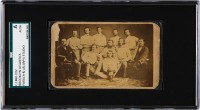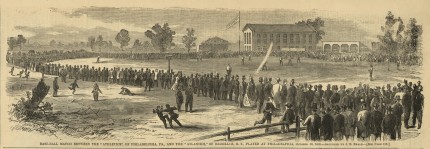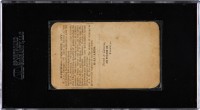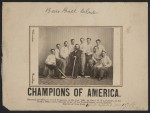 It’s a card and there’s a picture of a baseball team on it, but it’s not a baseball card in the classic sense. It’s not a trade card, printed by a business to promote a product. It’s not part of a series depicting multiple players and teams. It is a precursor and a very important one because not only does the card feature the Brooklyn Atlantics, baseball’s first champion team, but it dates to 1859 or 1860 making it the only team card known to have been printed before the Civil War. It’s one of a kind, as far as we know, and unlike the 1865 Brooklyn Atlantics card that sold at auction in 2013 for $92,000, it has an impeccable ownership history.
It’s a card and there’s a picture of a baseball team on it, but it’s not a baseball card in the classic sense. It’s not a trade card, printed by a business to promote a product. It’s not part of a series depicting multiple players and teams. It is a precursor and a very important one because not only does the card feature the Brooklyn Atlantics, baseball’s first champion team, but it dates to 1859 or 1860 making it the only team card known to have been printed before the Civil War. It’s one of a kind, as far as we know, and unlike the 1865 Brooklyn Atlantics card that sold at auction in 2013 for $92,000, it has an impeccable ownership history.
The 1860 Brooklyn Atlantics team card is a carte de visite (CDV), a studio photograph affixed to card stock to be handed out as a calling card. The technology to print multiple copies of photographs at comparatively cost was developed in France in the 1850s, and calling cards with photographs depicting their owners soon followed, as did collectible ones featuring celebrities, military and political figures. Photography studios would take the pictures and produce the cartes. The Atlantics CDV was produced by the Farach & Lalumia Studio at 336 Fulton Street, Brooklyn.
(Lurid digression time! Twenty-five years after the Atlantics had their picture taken by him and his partner, John Farach made the news when his brother Carmel was found stabbed twice, a small wound to the chest and the fatal one in his back, by a sword cane on Staten Island in 1884. Suspicion alighted on Carmel’s boon companion Antonio Flaccomio but he was released when the coroner declared the death suicide, as one does with backstabbings. Two years later Flaccomio confessed to John Farach that he had killed his brother during a duel. Farach didn’t buy it — his brother was left-handed, the sword cane was found in his right hand — and he told Flaccomio never to set foot in Brooklyn again or he’d kill him.
Two years after that on October 14th, 1888, Flaccomio was stabbed in the heart with a stiletto in front of Cooper Union in Manhattan and died. Farach was at first suspected of killing him in a vendetta, but the police soon refocused their attention on “the powerful secret Sicilian society known as ‘the Mafia'” who were thought to have ordered the hit because Flaccomio killed Carmel Farach without authorization or because he snitched out their counterfeiting operation to the cops. One Vincenzo Quartararo was arrested on the testimony of three supposed witnesses which was contradicted by other witnesses. The trial concluded with a hung jury, nine for acquittal, three for murder in the first, with the three holdouts insisting that Quartararo had to be guilty because he was Italian and Italians were always guilty of whatever crimes they were arrested for.)

The Brooklyn Atlantics club was established in 1855 and in 1857 would become one of the founding members of the National Association of Base Ball Players, the first official governing body of American baseball. The first year the NABBP teams played a full season, 1859, the Atlantics won the pennant. They won again in 1860. They won again in 1861. The early roster included Richard “Dickey” Pearce, pioneer of the shortstop position and inventor of the bunt, and outfielder Archibald McMahon.
 It was McMahon who kept this 1860 carte de visite of America’s first baseball champions. There’s a newspaper clipping from 1859 affixed to the back of the CDV that lists the nine players, probably pasted by McMahon himself. From him it passed to his brother John, and it was so treasured a memento that it got a mention in John’s 1928 obituary: “He also was an ardent baseball fan and had a picture in his home of the original Atlantics team, of which his brother, Archibald McMahon, was a member.” It has remained with John’s descendants ever since.
It was McMahon who kept this 1860 carte de visite of America’s first baseball champions. There’s a newspaper clipping from 1859 affixed to the back of the CDV that lists the nine players, probably pasted by McMahon himself. From him it passed to his brother John, and it was so treasured a memento that it got a mention in John’s 1928 obituary: “He also was an ardent baseball fan and had a picture in his home of the original Atlantics team, of which his brother, Archibald McMahon, was a member.” It has remained with John’s descendants ever since.
The card is being offered by western Massachusetts resident and New York native Florence Sasso, 75, the great grand-niece-in-law of Archibald McMahon, one of the players on The Brooklyn Atlantics. The card, which was given to Sasso by her mother, the late Mildred Sasso, spent the decades with various family members before ending up with Sasso’s mother, who kept it in a secret compartment in a piece of furniture the family inherited from an uncle.
Once the card was given to Sasso, she moved it from place to place — often from safekeeping in the pages of a book into another book — until she realized that the card, aside from being a link to her family history, could be quite valuable. Without children to pass it on to, Sasso has decided the time has come for a new caretaker for the artifact.
 There are only two other currently known Brooklyn Atlantic team CDVs, both produced by Williamson Studios in Brooklyn. One of them is in the Library of Congress where photographer Charles H. Williamson registered the prototype for copyright purposes in 1865. The other, the one auctioned off in 2013, is not identical — there are slight changes in the subjects’ postures — but it’s from the same photo shoot. There are some notable problems with the CDV sold in 2013. The photograph has been affixed to the card stock in a sloppy way. The adhesive shows through the photograph and the edges of the picture are rough making them stand out sharply from the card. It’s amateurish for studio work. There is concern among some experts that the photograph might have been recently glued to the backing of another Williamson CDV and indeed the first appraisers, Lelands auction house, declared it a fake and decline to accept it for consignment.
There are only two other currently known Brooklyn Atlantic team CDVs, both produced by Williamson Studios in Brooklyn. One of them is in the Library of Congress where photographer Charles H. Williamson registered the prototype for copyright purposes in 1865. The other, the one auctioned off in 2013, is not identical — there are slight changes in the subjects’ postures — but it’s from the same photo shoot. There are some notable problems with the CDV sold in 2013. The photograph has been affixed to the card stock in a sloppy way. The adhesive shows through the photograph and the edges of the picture are rough making them stand out sharply from the card. It’s amateurish for studio work. There is concern among some experts that the photograph might have been recently glued to the backing of another Williamson CDV and indeed the first appraisers, Lelands auction house, declared it a fake and decline to accept it for consignment.
 The reason could be more sinister than mere forgery: to disguise the evidence of an infamous theft. In the 1970s, more than 100 rare 19th century baseball images from the A. G. Spalding Baseball Collection in the New York Public Library’s Fifth Avenue Branch were stolen, along with a trove of documents and other pieces from the collection. Every once in a while suspicious items appear on the market, and according to a 1921 inventory, the NYPL collection had an 1865 Williamson Atlantics CDV with the exact same lineup in the same positions as the one sold in 2013. The NYPL stamps the back of their cards, so anyone trying to sell it would have had to replace the backing with an unmarked Williamson card. Peter Nash lays out the issues with the CDV here and here.
The reason could be more sinister than mere forgery: to disguise the evidence of an infamous theft. In the 1970s, more than 100 rare 19th century baseball images from the A. G. Spalding Baseball Collection in the New York Public Library’s Fifth Avenue Branch were stolen, along with a trove of documents and other pieces from the collection. Every once in a while suspicious items appear on the market, and according to a 1921 inventory, the NYPL collection had an 1865 Williamson Atlantics CDV with the exact same lineup in the same positions as the one sold in 2013. The NYPL stamps the back of their cards, so anyone trying to sell it would have had to replace the backing with an unmarked Williamson card. Peter Nash lays out the issues with the CDV here and here.
The auction house insisted this pearl of great price was discovered by a picker in a moldy old photograph album in someone’s garage in Maine, not that that obviates the possibility that it was stolen from the NYPL before winding up in a box of junk in a Maine garage. Whatever the truth of it, this $92,000 CDV has problems of condition, consistency and provenance. The 1860 CDV, on the other hand, could not be on more solid ground if you’d designed it in a time lab. The estimated price is $50,000+ and bids have already reached $22,000. The sale will take place on July 30th-31st at Heritage Auctions’ Platinum Night Sports auction in Chicago.